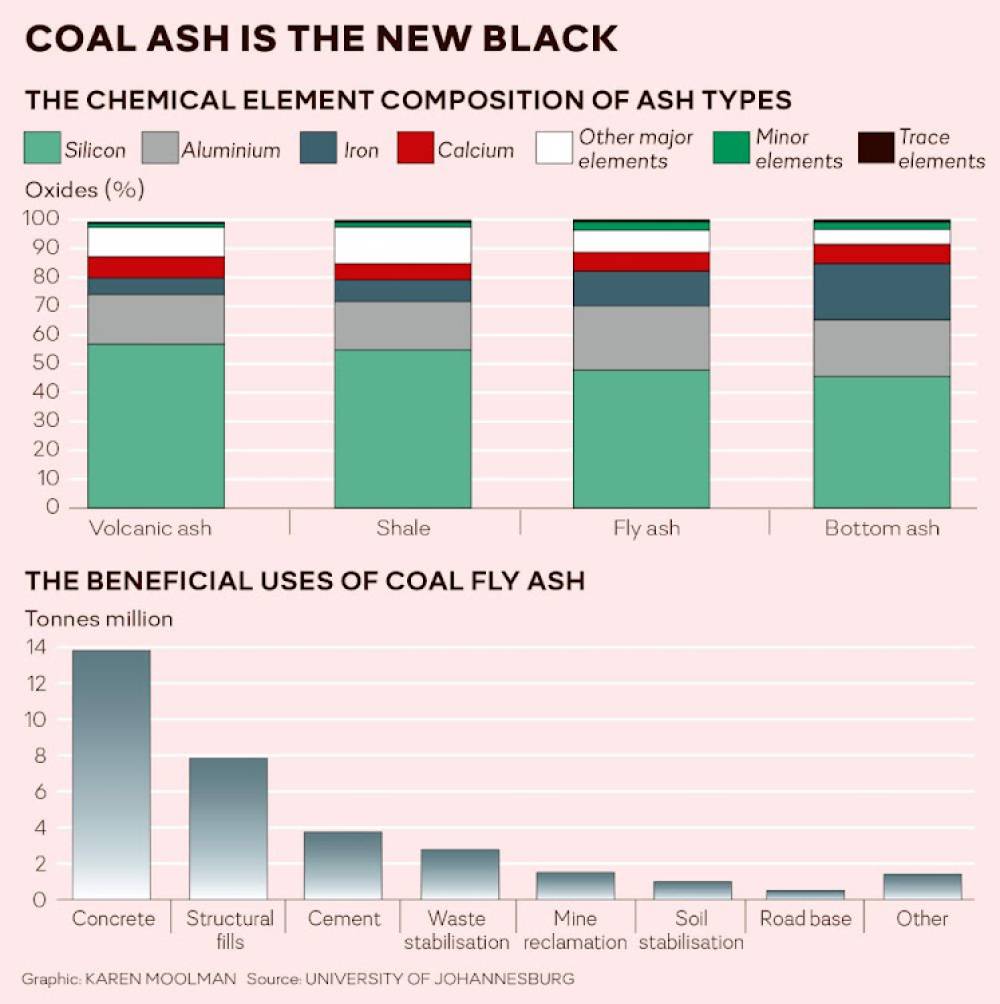
Nam Phi có kho báu đất hiếm từ tro bay than đá – cơ hội tạo việc làm và phục hồi ngành khai khoáng
-
Tro bay than đá – phần bụi mịn còn lại sau khi đốt than – được các nhà khoa học Mỹ phát hiện chứa lượng lớn nguyên tố đất hiếm, mở ra hướng khai thác mới ngoài quặng tự nhiên.
-
Đất hiếm gồm 17 nguyên tố như yttrium và scandium, rất quan trọng trong ô tô điện, năng lượng tái tạo, chất bán dẫn, pin, radar và vũ khí chính xác.
-
Trung Quốc hiện tinh luyện đến 90% đất hiếm toàn cầu, trong khi Mỹ từng nhập 75% lượng đất hiếm từ Trung Quốc trong giai đoạn 2019–2022.
-
Trước việc Trung Quốc siết xuất khẩu để đáp trả thuế của Mỹ, các nước đang gấp rút tìm nguồn cung thay thế, trong đó có khai thác từ nguồn thứ cấp như tro bay.
-
Nam Phi có 15 nhà máy nhiệt điện than tiêu thụ khoảng 109 triệu tấn than/năm và tạo ra 25 triệu tấn tro bay/năm, theo số liệu từ Eskom.
-
Một nhà máy công suất 3.600MW có thể tạo ra 20.000 tấn tro bay mỗi ngày – một tiềm năng khổng lồ cho đất hiếm.
-
-
Chiến lược khoáng sản và kim loại quan trọng của Nam Phi, được chính phủ phê duyệt năm 2025, xếp đất hiếm vào nhóm có độ ưu tiên cao, đặc biệt từ nguồn tro bay.
-
Chiến lược khuyến khích đầu tư vào khai thác từ nguồn thứ cấp, đẩy mạnh nghiên cứu, chế biến và nâng cao chuỗi giá trị khoáng sản trong nước.
-
Trong năm 2024, Nam Phi mất gần 13.000 việc làm ngành khai khoáng, và tiếp tục giảm đầu 2025 – nên khai thác đất hiếm từ tro bay có thể mở ra hướng mới để tạo việc làm bền vững.
-
Theo Market.us, thị trường đất hiếm toàn cầu năm 2025 đạt 15,35 tỷ USD (~271 tỷ rand) và sẽ tăng lên 33,46 tỷ USD vào năm 2032, tốc độ tăng trưởng 10,4%/năm.
-
Nam Phi có lợi thế kết hợp giữa tiềm lực công nghiệp và nguồn tài nguyên, là điều kiện lý tưởng để phát triển mô hình greenfield mining (khai khoáng hoàn toàn mới) – điều mà quốc gia chưa thực hiện trong 30 năm qua.
📌 Với hơn 25 triệu tấn tro bay từ 15 nhà máy nhiệt điện mỗi năm, Nam Phi nắm giữ kho báu đất hiếm chưa được khai phá. Trong bối cảnh Trung Quốc siết xuất khẩu và thế giới khát nguyên liệu, đầu tư vào khai thác đất hiếm từ tro bay có thể mang lại việc làm, tăng trưởng và khôi phục ngành khai khoáng đang suy giảm của quốc gia.
https://www.businesslive.co.za/bd/opinion/2025-07-09-clarence-tshitereke-rare-earth-from-coal-fly-ash-our-untapped-treasure-trove/
CLARENCE TSHITEREKE: Rare earth from coal fly ash, our untapped treasure trove
A compelling growth area in greenfield mining investment and operations exists
09 July 2025 - 05:00
by Clarence Tshitereke
CLARENCE TSHITEREKE: Rare earth from coal fly ash, our untapped treasure trove
A compelling growth area in greenfield mining investment and operations exists
09 July 2025 - 05:00
by Clarence Tshitereke
The race is on to increase the supply of rare earth metals to meet increasing global demand. Recently, scientists in the US have discovered a bounty of rare earth metals embedded in coal fly ash.
Coal ash is the general term for all solid waste remaining after coal combustion, while coal fly ash is a specific component of coal ash consisting of fine particles carried away by exhaust gases. The latter is typically collected from the exhaust stacks using electrostatic precipitators or other filtration systems.
In theory, this means rare earth metals can be extracted from coal-fired power stations through the installation of exhaust stacks using electrostatic precipitators or other filtration systems, as explained above.
In the periodic table of elements, rare earth metals are a group of 17 soft heavy metallic elements of the lanthanide series, often with exotic names, such as scandium and yttrium. While these metals are abundant on the earth’s crust, their limited primary extraction at usable qualities requires processing of raw ore at a premium.
Currently, China leads the production of rare earth metals with at least 90% of refined global output, followed by Australia and Myanmar.
Rare earth metals are critical for the manufacture of advanced modern technologies, including electric vehicles, renewable energy, semiconductors, smartphones, batteries, magnets, optical fibres and various cutting-edge military applications such as precision-guided missiles and radar systems. The level of global dependence is such that the EU relies on China for as much as 98% of the rare earth metals needed to meet its needs.
With China imposing restrictions on the exports of certain rare earth metals, the race is on to diversity supply chains as countries seek to mitigate potential supply disruptions and associated vulnerabilities. China’s restrictions are in response to US tariffs as high as 145% imposed on Chinese imports to the US and associated trade policies — which are considered punitive. It is estimated that about 75% of rare earth metals imported to the US from 2019-22 came from China.
Chinese restrictions underscore a broader strategy to leverage dominance in rare earth production in advancing geopolitical interests and international relations. Conservative estimates are that it would take at least 10 years to build a rare earth metal supply chain processing capacity. The strategic use of rare earth metals as leverage in contemporary geopolitics calls for diversified supply sources. The EU is targeting production of at least 7,000 tonnes of rare earth metals in the coming years to meet its growing demand.
As rare earth metal supply chain anxieties deepen, scientists are figuring out how to extract such metals from coal fly ash — and SA should not be left behind. SA has 15 active coal-fired power stations, which consume about 109-million tonnes of coal a year and produce 25-million tonnes of ash. According to Eskom, on average a coal-fired power station with a total output of 3,600MW consumes about 50,000 tonnes of coal a day and produces at least 20, 000 tonnes of ash a day, depending on coal quality, caloric value and ash content.
This inventory of coal-fired power stations presents opportunities for rare earth extraction. This requires government commitment to substantial long-term investment in industrial-scale extractive capacity of rare earth metals from coal fly ash. There is value in such investments as the demand for rare earth metals is projected to increase exponentially by 2040. Therefore, harnessing national industrial capacity towards innovative ways through which a new rare earth metal extractive capacity can be established must remain our constant concern.
Recently, the SA cabinet approved the critical minerals and metals strategy for SA, a primary policy requirement towards leveraging mineral resources for economic growth, industrial development and job creation in the 21st century. Among other things, the strategy seeks to consolidate SA’s R&D investment in mineral resources, value addition and beneficiation.
The strategy identifies and classifies rare earth metals as minerals with moderate to high criticality, with potential for economically recoverable grades from coal fly ash. The strategy also recognises the need to build national competence to extract minerals from secondary sources, including rare earth elements from coal fly ash.
Therefore, rare earth metal extraction from coal fly ash offers a critical opportunity to leverage our minerals endowment in a manner that promotes inclusive growth, industrial development, job creation and economic transformation against the accelerating trend of closing mining projects. The potential of job creation is critical.
In 2024 alone there were significant job losses in the mining sector, shedding almost 13,000 jobs, with a further decline in the first quarter of 2025. Perhaps the challenges facing our mining sector are untenable, but it is fair to argue that jobs in the sector will have to come from investments in new extractive capacities such as rare earth metals. It is jobs that sustain families, households and their livelihoods.
According to Market.us, this year the global rare earth metals market was valued at $15.35bn (R271bn in today’s rand exchange value), and is projected to grow at a compound annual growth rate of 10.4% to reach $33.46bn by 2032.
Rare earth metal extractive capacity therefore presents a compelling growth area in greenfield mining investment and operations — which SA has not had in the past 30 years.
As a pre-eminently mining nation, SA combines both comparative and competitive advantages to succeed in extracting rare earth from coal fly ash. These advantages, combined with mature industrial capacity, present a valuable niche in our national mineral heritage.
Thảo luận
Follow Us
Tin phổ biến



